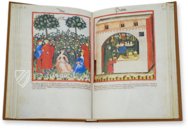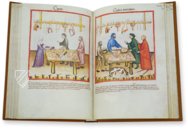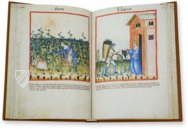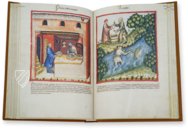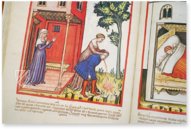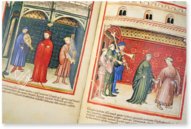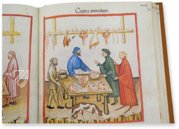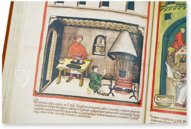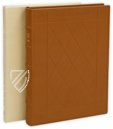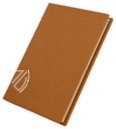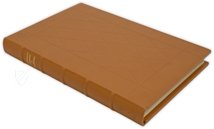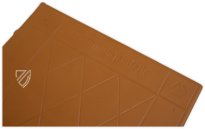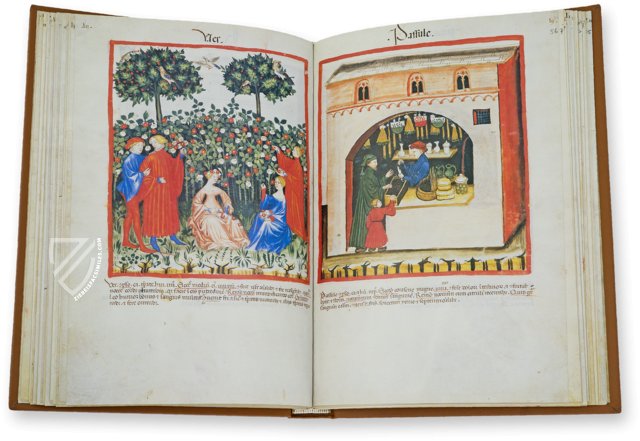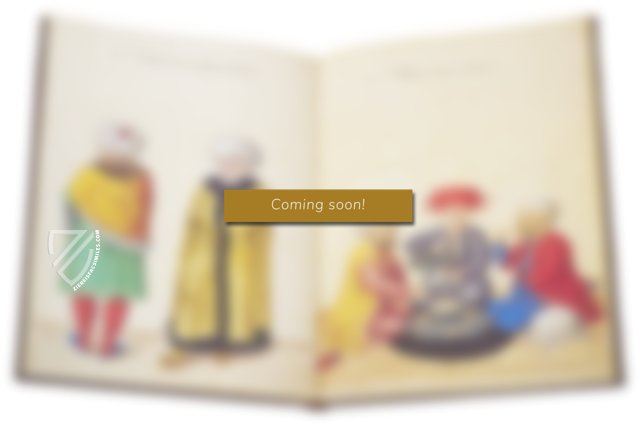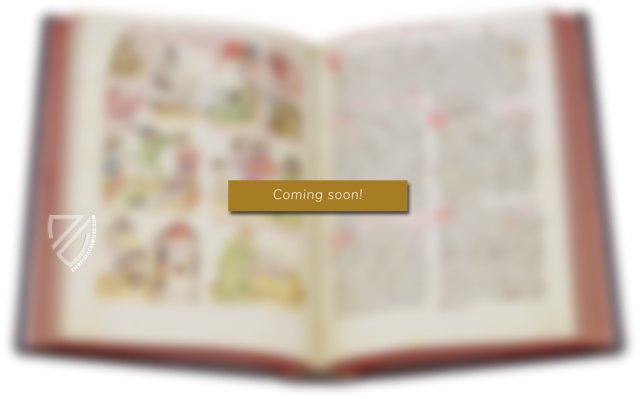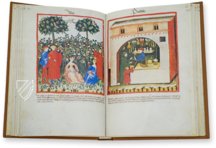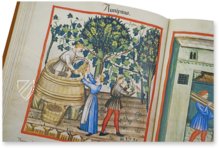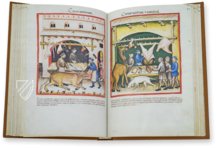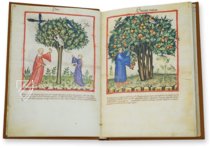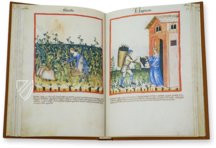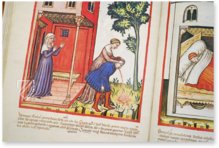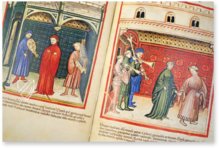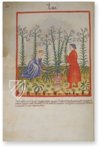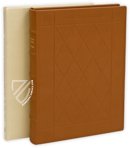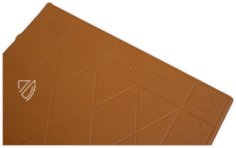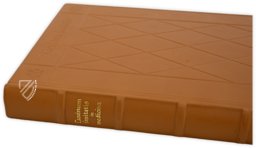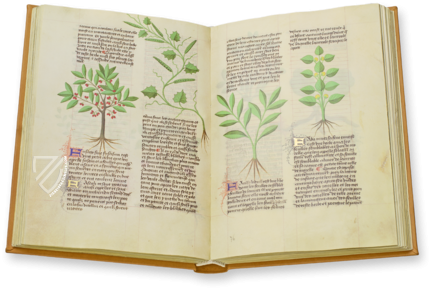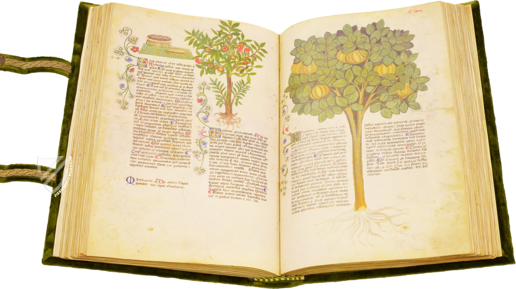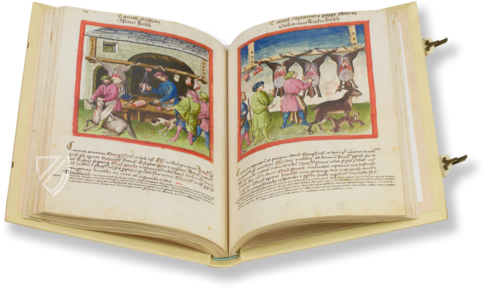Tacuinum Sanitatis in Medicina
(1,000€ - 3,000€)
One of the most aesthetic examples of the outstanding reputation of Arabic medicine in the Middle Ages is the Taqwim es-sihha by the physician Ibn Butlan, who wrote this genre-defining work around the middle of the 11th century in Baghdad or Antioch. The title in Arabic means "Tabular Survey of Health." Ibn Butlan compiled over 200 objects from the perspective of their influence on human health: from foods such as camel meat and melons to the seasons and music. The unillustrated Arabic text was translated into Latin at the court of Manfred of Sicily (r. 1258–1266) and the title was Latinized as Tacuinum sanitatis. In this magnificent manuscript, the images resemble panel paintings. They tell complete stories to the viewer, always making one thing clear: the context and significance of the objects for human health.
A medical housebook with 206 miniatures
The Tacuinum sanitatis in medicina (”Overview of Medicine in Tabular Form”) is among the most beautifully and richly decorated manuscripts in the Austrian National Library. This lavishly illustrated medical handbook was conceived for a lay public, more precisely for members of the high nobility or wealthy patrician families, who could afford and read such an expensive "reference work" for household management, health care and cure.
This type of book goes back to an Arab source written by the Christian physician Ibn Butlan in the 11th century, known as Taqwim es-sihha. The Arab art and practice of healing, which preserved a great amount of ancient knowledge, decisively influenced Western medicine in the Middle Ages and had a great reputation. The Latin translation, which made the text accessible to the educated of the medieval western world in the first place, was widely known judging from the large number of surviving manuscripts.
While the famous work initially consisted only of synoptic tables without any illumination, from the 14th century onwards it was richly furnished with large images, so that the texts were shortened to a few lines. One of the oldest and certainly also finest manuscripts of this kind is the Tacuinum presented here, which depicts on 206 colorful full-page miniatures everything that was connected with human health and well-being at the time the original was written.
A Testimony to Famous Oriental Cure
"Tacuinum" is the Latinized form of the Arab word "Taqwim", which remained untranslated. Since the work was widely read, especially in Italy, the word "Tacuinum" was also adopted into the Italian language: "Tacuino" in Italian today means something like "notebook".
The very well-known medieval physician Ibn Butlan († c. 1065), whose full name was Abū l-Ḥasan al-Muḫtār bin al-Ḥasan bin ʿAbdūn bin Saʿdūn bin Buṭlān, wrote the extensive Taqwim es-sihha in the 11th century, among several other medical works, and acquired great fame. In the 13th century, this work, consisting of synoptic tables without illustrations, was probably translated into Latin at the court of King Manfred of Sicily, whereupon it became increasingly widespread in Latin Europe and eventually had a long-lasting influence on Western medicine.
A Sumptuous Monument to Book Illumination
The work is not only important for historically interested physicians and pharmacists, but is also a comprehensive and fascinating object of extensive study for bibliophiles and researchers of book illumination because of its more than 200 miniatures. In addition, its depictions display an evocative image of old Italian culture as well as many aspects of daily life, making it also a rich source of cultural history.
The Tacuinum was probably commissioned by Giangaleazzo Visconti (1351–1402) at the end of the 14th century in the workshop of his favorite artist Giovannino de' Grassi (1340s–1398). The coat of arms on fol. 3v suggests that the luxurious manuscript was a political gift to a member of the Speroni family from Padua, who frequented the court of Milan after Giangaleazzo's conquest of Verona. It was made by two talented painters whose naturalism and powers of observation are particularly surprising. The chosen colors are very strong and give the miniatures a charming freshness and liveliness.
A Medical Picture Book
The 206 full-page miniatures depict numerous materiae medicae, which included not only plants, animals, foods, and processed medicines, but also winds, seasons, and other environmental phenomena such as emotions and leisure activities. Their effects on the human organism are described on the basis of ancient medical teachings. So, in a few lines under each image, the benefits and harms of the respective materia medica for differently constituted humans are succinctly explained.
Thus the Tacuinum constitutes a medical picture book, which, although in the tradition of ancient herbals, belongs with its dominating miniatures to a new genre of medical codices. The special feature of the pictorial representations is that the individual materiae medicae are not depicted alone, but, as in the text, are centered on the human being. Man is alwayss shown dealing with the respective plants, animals and other things. However, the depiction did not aim at an exact recognizability or precise illustration of the advice described in the text with regard to preparation and ingestion. Rather, naturalistic genre scenes emerge, which, with their rich stock of utensils, demonstrate much of the habits and living conditions of citizens of a late medieval Italian city and presented the originally addressed aristocratic viewers an idealized image of their realm.
In addition to its great importance for the history of civilization, the Tacuinum is fascinating contemporary readers as it provides an opportunity to compare modern natural cures and healthy living practices with those used nearly 600 years ago.
Codicology
- Alternative Titles
- Códice de Cerruti
Das Hausbuch der Cerruti
Taqwim-as-Sihha
Tacuinum Sanitatis
Theatrum Sanitatis
Theatrum Sanitatis - Size / Format
- 214 pages / 33.2 × 23.0 cm
- Origin
- Italy
- Date
- End of the 14th century
- Epochs
- Style
- Language
- Script
- Italian Rotunda
- Illustrations
- 206 full-page miniatures, 2 pages coat-of-arms
- Patron
- Probably Giangaleazzo Visconti
- Artist / School
- Probably Giovannino de’ Grassi and his workshop
- Previous Owners
- Alvarotto or Pietro Speroni
George I von Liechtenstein, Bishop of Trent
Tacuinum Sanitatis - Codex Paris
The Tailor’s Shop
Bearing the caption Uestis Ianea or “Woolen Clothes” this scene shows a medieval tailor’s shop. The tailor is beautifully dressed in red, a very fashionable color in the 14th century, as he takes some final measurements on his customer’s brilliant blue coat, which he holds in place by pressing his left hand to his chest. Two young beardless apprentices sit sewing and watching their master surrounded by various works in progress as well as a pair of scissors.
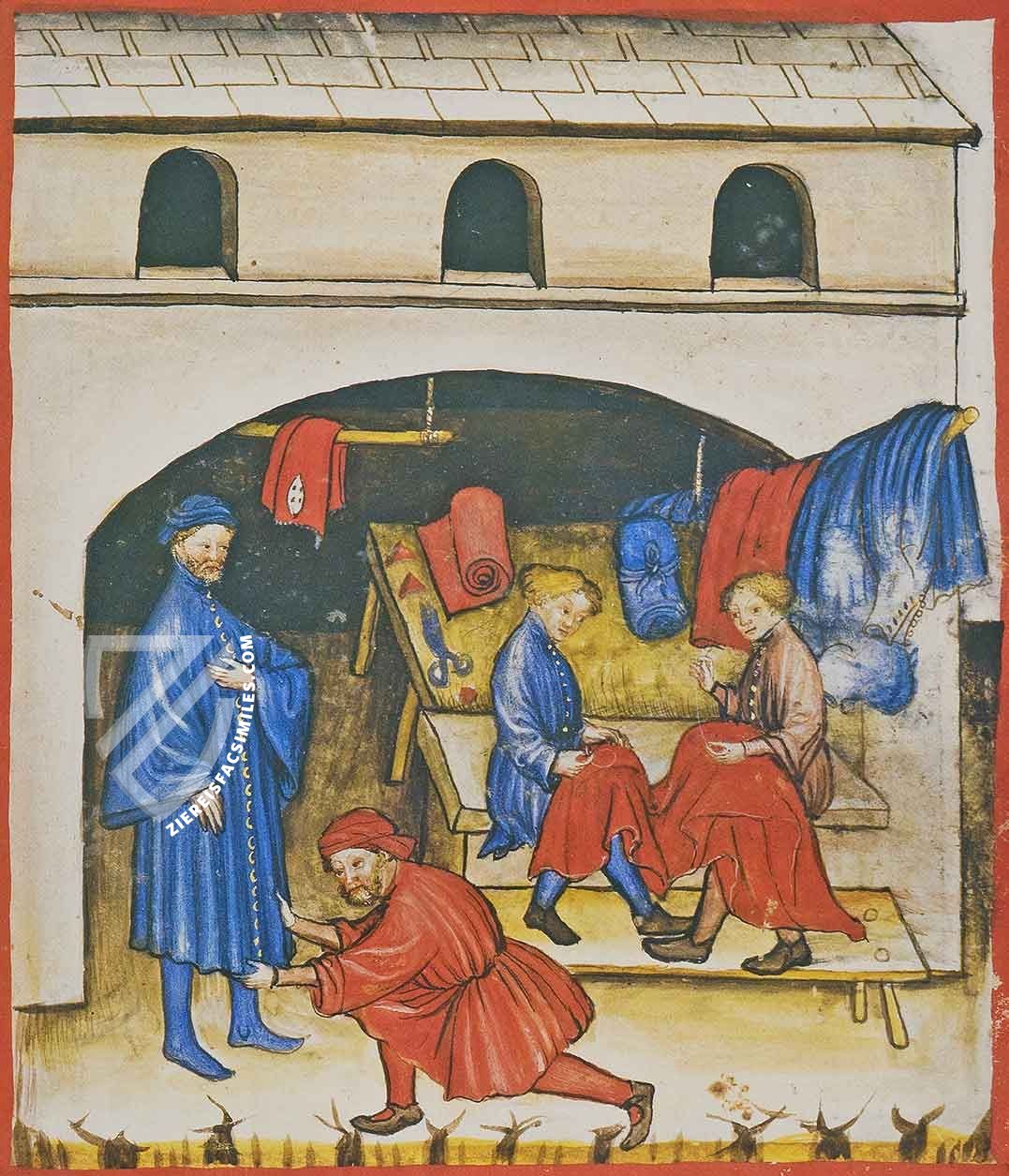
Tacuinum Sanitatis
Harvesting Sour Apples
Like in the rest of the manuscript, this splendid miniature is presented in a conspicuously simple red frame that allows the beholder to focus on the great care taken by the artist in creating it. Heavy with fruit, the tree itself is extremely detailed with various shades of green employed by the artist to give it a sense of depth.
Leaves and apples are depicted in midair as a man in an embroidered blue tunic and red tights uses a pole to knock them loose. A woman in a flowing red dress and a blue blouse uses her right hand to shield her face from the falling fruit as she holds an empty basket with her left. Aside from its pastoral idealism, the image is remarkable for its near-perfect symmetry with regard to both form and color.
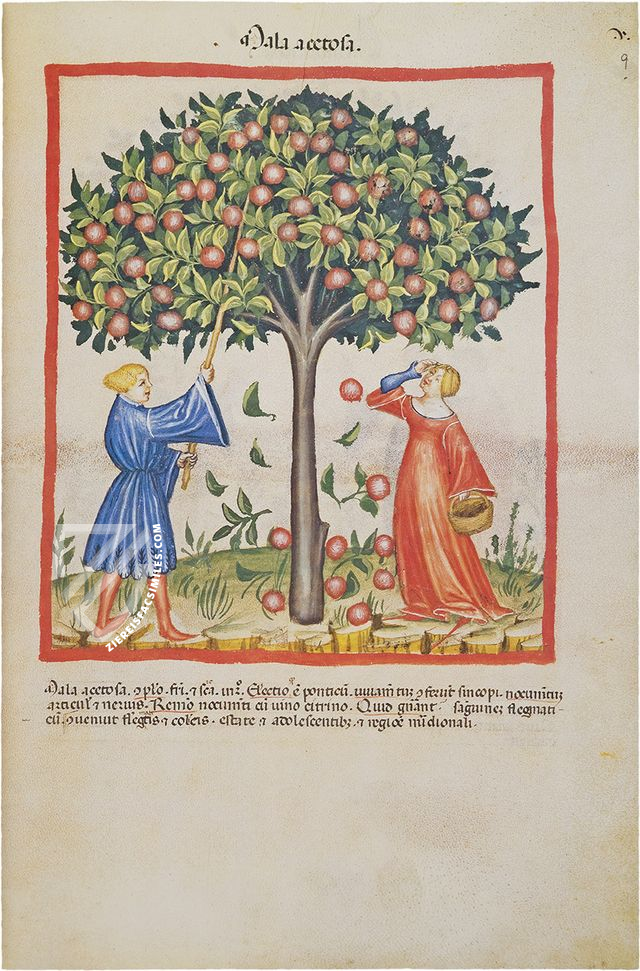
#1 Tacuinum Sanitatis in Medicina
Language: German
The facsimile edition is accompanied by a scholarly commentary from Franz Unterkircher. It describes the outward appearance of the manuscript and its history in great detail, introduces the author and his work, and explores a number of art historical issues. The commentary is complete with a transcription of the Latin text and a German and English version (the latter being a translation by Heide Saxer and Charles H. Talbot), which makes it a helpful guide to understanding the facsimile.
Preface by J. Stummvoll, Vienna. Introduction, transcription of the latin text and translation of the captions into German by F. Unterkircher, Vienna. Translation of the captions into English by H. Saxer, Vienna, and C. H. Talbot, London. 148 pp. text and 8 plates on art print. Half leather with paper parchment.
(1,000€ - 3,000€)
#2 Tacuinum Sanitatis in Medicina
Language: Italian
(1,000€ - 3,000€)
#3 Códice de Cerruti
(under 1,000€)
- Treatises / Secular Books
- Apocalypses / Beatus
- Astronomy / Astrology
- Bestiaries
- Bibles / Gospels
- Chronicles / History / Law
- Geography / Maps
- Saints' Lives
- Islam / Oriental
- Judaism / Hebrew
- Single Leaf Collections
- Leonardo da Vinci
- Literature / Poetry
- Liturgical Manuscripts
- Medicine / Botany / Alchemy
- Music
- Mythology / Prophecies
- Psalters
- Other Religious Books
- Games / Hunting
- Private Devotion Books
- Other Genres
- Afghanistan
- Armenia
- Austria
- Belgium
- Belize
- Bosnia and Herzegovina
- China
- Colombia
- Costa Rica
- Croatia
- Cyprus
- Czech Republic
- Denmark
- Egypt
- El Salvador
- Ethiopia
- France
- Germany
- Greece
- Guatemala
- Honduras
- Hungary
- India
- Iran
- Iraq
- Israel
- Italy
- Japan
- Jordan
- Kazakhstan
- Kyrgyzstan
- Lebanon
- Liechtenstein
- Luxembourg
- Mexico
- Morocco
- Netherlands
- Palestine
- Panama
- Peru
- Poland
- Portugal
- Romania
- Russia
- Serbia
- Spain
- Sri Lanka
- Sweden
- Switzerland
- Syria
- Tajikistan
- Turkey
- Turkmenistan
- Ukraine
- United Kingdom
- United States
- Uzbekistan
- Vatican City
- A. Oosthoek, van Holkema & Warendorf
- Aboca Museum
- Ajuntament de Valencia
- Akademie Verlag
- Akademische Druck- u. Verlagsanstalt (ADEVA)
- Aldo Ausilio Editore - Bottega d’Erasmo
- Alecto Historical Editions
- Alkuin Verlag
- Almqvist & Wiksell
- Amilcare Pizzi
- Andreas & Andreas Verlagsbuchhandlung
- Archa 90
- Archiv Verlag
- Archivi Edizioni
- Arnold Verlag
- ARS
- Ars Magna
- ArtCodex
- AyN Ediciones
- Azimuth Editions
- Badenia Verlag
- Bärenreiter-Verlag
- Belser Verlag
- Belser Verlag / WK Wertkontor
- Benziger Verlag
- Bernardinum Wydawnictwo
- BiblioGemma
- Biblioteca Apostolica Vaticana (Vaticanstadt, Vaticanstadt)
- Bibliotheca Palatina Faksimile Verlag
- Bibliotheca Rara
- Boydell & Brewer
- Bramante Edizioni
- Bredius Genootschap
- Brepols Publishers
- British Library
- C. Weckesser
- Caixa Catalunya
- Canesi
- CAPSA, Ars Scriptoria
- Caratzas Brothers, Publishers
- Carus Verlag
- Casamassima Libri
- Centrum Cartographie Verlag GmbH
- Chavane Verlag
- Christian Brandstätter Verlag
- Circulo Cientifico
- Club Bibliófilo Versol
- Club du Livre
- CM Editores
- Collegium Graphicum
- Collezione Apocrifa Da Vinci
- Comissão Nacional para as Comemorações dos Descobrimentos Portugueses
- Coron Verlag
- Corvina
- CTHS
- D. S. Brewer
- Damon
- De Agostini/UTET
- De Nederlandsche Boekhandel
- De Schutter
- Deuschle & Stemmle
- Deutscher Verlag für Kunstwissenschaft
- DIAMM
- Droz
- E. Schreiber Graphische Kunstanstalten
- Ediciones Boreal
- Ediciones Grial
- Ediclube
- Edições Inapa
- Edilan
- Editalia
- Edition Deuschle
- Edition Georg Popp
- Edition Leipzig
- Edition Libri Illustri
- Editiones Reales Sitios S. L.
- Éditions de l'Oiseau Lyre
- Editions Medicina Rara
- Editorial Casariego
- Editorial Mintzoa
- Editrice Antenore
- Editrice Velar
- Edizioni Edison
- Egeria, S.L.
- Eikon Editores
- Electa
- Emery Walker Limited
- Enciclopèdia Catalana
- Eos-Verlag
- Ephesus Publishing
- Ernst Battenberg
- Eugrammia Press
- Extraordinary Editions
- Fackelverlag
- Facsimila Art & Edition
- Facsimile Editions Ltd.
- Facsimilia Art & Edition Ebert KG
- Faksimile Verlag
- Feuermann Verlag
- Folger Shakespeare Library
- Franco Cosimo Panini Editore
- Friedrich Wittig Verlag
- Fundación Hullera Vasco-Leonesa
- G. Braziller
- Gabriele Mazzotta Editore
- Gebr. Mann Verlag
- Gesellschaft für graphische Industrie
- Getty Research Institute
- Giovanni Domenico de Rossi
- Giunti Editore
- Graffiti
- Grafica European Center of Fine Arts
- Guido Pressler
- Guillermo Blazquez
- Gustav Kiepenheuer
- H. N. Abrams
- Harrassowitz
- Harvard University Press
- Helikon
- Hendrickson Publishers
- Henning Oppermann
- Herder Verlag
- Hes & De Graaf Publishers
- Hoepli
- Holbein-Verlag
- Houghton Library
- Hugo Schmidt Verlag
- Idion Verlag
- Il Bulino, edizioni d'arte
- ILte
- Imago
- Insel Verlag
- Instituto de Estudios Altoaragoneses
- Instituto Nacional de Antropología e Historia
- Istituto dell'Enciclopedia Italiana - Treccani
- Istituto Ellenico di Studi Bizantini e Postbizantini
- Istituto Geografico De Agostini
- Istituto Poligrafico e Zecca dello Stato
- Italarte Art Establishments
- Jan Thorbecke Verlag
- Johnson Reprint Corporation
- Josef Stocker
- Josef Stocker-Schmid
- Jugoslavija
- Karl W. Hiersemann
- Kasper Straube
- Kaydeda Ediciones
- Kindler Verlag / Coron Verlag
- Kodansha International Ltd.
- Konrad Kölbl Verlag
- Kurt Wolff Verlag
- La Liberia dello Stato
- La Linea Editrice
- La Meta Editore
- Lambert Schneider
- Landeskreditbank Baden-Württemberg
- Leo S. Olschki
- Les Incunables
- Liber Artis
- Library of Congress
- Libreria Musicale Italiana
- Lichtdruck
- Lito Immagine Editore
- Lumen Artis
- Lund Humphries
- M. Moleiro Editor
- Maison des Sciences de l'homme et de la société de Poitiers
- Manuscriptum
- Martinus Nijhoff
- Maruzen-Yushodo Co. Ltd.
- MASA
- Massada Publishers
- McGraw-Hill
- Metropolitan Museum of Art
- Militos
- Millennium Liber
- Müller & Schindler
- Nahar - Stavit
- Nahar and Steimatzky
- National Library of Wales
- Neri Pozza
- Nova Charta
- Oceanum Verlag
- Odeon
- Orbis Mediaevalis
- Orbis Pictus
- Österreichische Staatsdruckerei
- Oxford University Press
- Pageant Books
- Parzellers Buchverlag
- Patrimonio Ediciones
- Pattloch Verlag
- PIAF
- Pieper Verlag
- Plon-Nourrit et cie
- Prestel Verlag
- Princeton University Press
- Prisma Verlag
- Priuli & Verlucca, editori
- Pro Sport Verlag
- Propyläen Verlag
- Pytheas Books
- Quaternio Verlag Luzern
- Reales Sitios
- Recht-Verlag
- Reichert Verlag
- Reichsdruckerei
- Reprint Verlag
- Riehn & Reusch
- Roberto Vattori Editore
- Rosenkilde and Bagger
- Roxburghe Club
- Salerno Editrice
- Saltellus Press
- Sandoz
- Sarajevo Svjetlost
- Schöck ArtPrint Kft.
- Schulsinger Brothers
- Scolar Press
- Scrinium
- Scripta Maneant
- Scriptorium
- Shazar
- Siloé, arte y bibliofilia
- SISMEL - Edizioni del Galluzzo
- Sociedad Mexicana de Antropología
- Société des Bibliophiles & Iconophiles de Belgique
- Soncin Publishing
- Sorli Ediciones
- Stainer and Bell
- Studer
- Styria Verlag
- Sumptibus Pragopress
- Szegedi Tudomànyegyetem
- Taberna Libraria
- Tarshish Books
- Taschen
- Tempus Libri
- Testimonio Compañía Editorial
- Thames and Hudson
- The Clear Vue Publishing Partnership Limited
- The Facsimile Codex
- The Folio Society
- The Marquess of Normanby
- The Richard III and Yorkist History Trust
- Tip.Le.Co
- TouchArt
- TREC Publishing House
- TRI Publishing Co.
- Trident Editore
- Typis Regiae Officinae Polygraphicae
- Union Verlag Berlin
- Universidad de Granada
- University of California Press
- University of Chicago Press
- Urs Graf
- Vallecchi
- Van Wijnen
- VCH, Acta Humaniora
- VDI Verlag
- VEB Deutscher Verlag für Musik
- Verlag Anton Pustet / Andreas Verlag
- Verlag Bibliophile Drucke Josef Stocker
- Verlag der Münchner Drucke
- Verlag für Regionalgeschichte
- Verlag Styria
- Vicent Garcia Editores
- W. Turnowski Ltd.
- W. Turnowsky
- Waanders Printers
- Wiener Mechitharisten-Congregation (Wien, Österreich)
- Wissenschaftliche Buchgesellschaft
- Wissenschaftliche Verlagsgesellschaft
- Wydawnictwo Dolnoslaskie
- Xuntanza Editorial
- Zakład Narodowy
- Zollikofer AG




